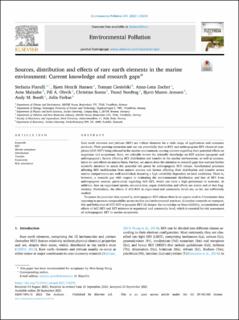Sources, distribution and effects of rare earth elements in the marine environment: Current knowledge and research gaps
| dc.contributor.author | Piarulli, Stefania | |
| dc.contributor.author | Hansen, Bjørn Henrik | |
| dc.contributor.author | Ciesielski, Tomasz Maciej | |
| dc.contributor.author | Zocher, Anna-Lena | |
| dc.contributor.author | Malzahn, Arne | |
| dc.contributor.author | Olsvik, Pål Asgeir | |
| dc.contributor.author | Sonne, Christian | |
| dc.contributor.author | Nordtug, Trond | |
| dc.contributor.author | Jenssen, Bjørn Munro | |
| dc.contributor.author | Booth, Andy | |
| dc.contributor.author | Farkas, Julia | |
| dc.date.accessioned | 2021-11-29T12:58:39Z | |
| dc.date.available | 2021-11-29T12:58:39Z | |
| dc.date.created | 2021-09-28T10:32:34Z | |
| dc.date.issued | 2021 | |
| dc.identifier.citation | Environmental Pollution (1987). 2021, 291:118230 1-15. | en_US |
| dc.identifier.issn | 0269-7491 | |
| dc.identifier.uri | https://hdl.handle.net/11250/2831933 | |
| dc.description.abstract | Rare earth elements and yttrium (REY) are critical elements for a wide range of applications and consumer products. Their growing extraction and use can potentially lead to REY and anthropogenic-REY chemical complexes (ACC-REY) being released in the marine environment, causing concern regarding their potential effects on organisms and ecosystems. Here, we critically review the scientific knowledge on REY sources (geogenic and anthropogenic), factors affecting REY distribution and transfer in the marine environment, as well as accumulation in- and effects on marine biota. Further, we aim to draw the attention to research gaps that warrant further scientific attention to assess the potential risk posed by anthropogenic REY release. Geochemical processes affecting REY mobilisation from natural sources and factors affecting their distribution and transfer across marine compartments are well established, featuring a high variability dependent on local conditions. There is, however, a research gap with respect to evaluating the environmental distribution and fate of REY from anthropogenic sources, particularly regarding ACC-REY, which can have a high persistence in seawater. In addition, data on organismal uptake, accumulation, organ distribution and effects are scarce and at best fragmentary. Particularly, the effects of ACC-REY at organismal and community levels are, so far, not sufficiently studied. To assess the potential risks caused by anthropogenic REY release there is an urgent need to i) harmonise data reporting to promote comparability across studies and environmental matrices, ii) conduct research on transport, fate and behaviour of ACC-REY vs geogenic REY iii) deepen the knowledge on bioavailability, accumulation and effects of ACC-REY and REY mixtures at organismal and community level, which is essential for risk assessment of anthropogenic REY in marine ecosystems. | en_US |
| dc.language.iso | eng | en_US |
| dc.publisher | Elsevier | en_US |
| dc.rights | Navngivelse 4.0 Internasjonal | * |
| dc.rights.uri | http://creativecommons.org/licenses/by/4.0/deed.no | * |
| dc.subject | Risk assessment | en_US |
| dc.subject | Ecotoxicity | en_US |
| dc.subject | Transfer | en_US |
| dc.subject | Distribution | en_US |
| dc.subject | Marine ecosystem | en_US |
| dc.subject | REY | en_US |
| dc.title | Sources, distribution and effects of rare earth elements in the marine environment: Current knowledge and research gaps | en_US |
| dc.type | Peer reviewed | en_US |
| dc.type | Journal article | en_US |
| dc.description.version | publishedVersion | en_US |
| dc.rights.holder | © 2021 The Authors. | en_US |
| dc.source.pagenumber | 1-15 | en_US |
| dc.source.volume | 291 | en_US |
| dc.source.journal | Environmental Pollution (1987) | en_US |
| dc.identifier.doi | 10.1016/j.envpol.2021.118230 | |
| dc.identifier.cristin | 1939584 | |
| dc.relation.project | Norges forskningsråd: 301236 | en_US |
| dc.source.articlenumber | 118230 | en_US |
| cristin.ispublished | true | |
| cristin.fulltext | original | |
| cristin.qualitycode | 1 |
Files in this item
This item appears in the following Collection(s)
-
Publikasjoner fra CRIStin - SINTEF Ocean [1387]
-
SINTEF Ocean [1461]

